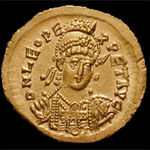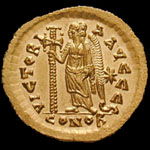
The beginning of the Byzantine coinage, been born in the Eastern Roman Empire after the fall of the Western Roman Empire of , is made to coincide with the monetary reform of Anastasius (491–518) in 498 A.C.
The monetary system was based on coins in gold and in bronze.
The gold coin was the solidus, with its sottomultiplis semisse (equal to 1/2 of the solidus) and tremisse (equal to 1/3 of the solidus). The value of a solidus was of 1/72 of the Roman pound, correspondents to 4,5 grams.


The base for the coinage in bronze was the nummus, an extremely small coin (around 8-10mm), and its multiples as the follis were used, broadly equal to 40 nummi. In the front of these coins were represented stylized images of the emperor, while the back showed the value of the coin according to the Greek numerical system (M=40, K=20, I=10, E=5).
Concerning the coinage in silver, not so commonly used, the miliarense and the siliqua were produced, with a value of 1/12 and 1/24 of solidus.
Characteristic of the solid, base of the monetary system, was the legenda COMOB that appeared on the coin, abbreviation of the title Comes Sacrarum Largitionum (Master of the Sacred Largess), the authority that checked the the finances of the empire since Costantino, while OB, (= obryzum) pointed out the purity of the gold. The types of solid were maintained stable enough: to the obverse the emperor's bust, without any connotation and to the reverse the Victoria with the cross and the globe, replaced after Giustiniano by the personification of Constantinople. A further innovation destined to last, except a brief interval with Maurice Tiberio (582-602), was the substitution of the type of reverse with a cross on steps, wanted by Tiberio II (578-582).
Beginning in 538, after the reform of Justinian (527-565), the coins in bronze brought elements of identification, like the date and the indication of the mint, to guarantee their nominal value. As silver coin, the siliqua continued to be minted.
When the gold started to be scarce, begun the issuing of silver coins like the Hexagram (so defined for its weight of six scruples = gr. 6,7). Such coin, used for the military expenses, was very appreciated also by the Muslims, who largely used this coins, forcing the Byzantine empire since Costantine IV (668-685) to contract its minting. In parallel, the bronze coins reduced their weight: the follis weighed less than one third of its initial weight and its fractions were no more coined; the last consistent issues in bronze are the ones of Constant II (641-668).
In the 721 Leo III it restored the miliarense in silver, whose value corresponded to 1/1000 of gold pound and to 1/12 of the solidus and perhaps to 288 follis, characterized to the obverse by a legend in honor of the Christus Victor. Such innovation lasted less than one century, up to that Michael III in the 843 who used the old image of the benedictory Christ. The abundant issues of the miliarense definitely replaced the fractions of the gold, simplifying the system, that was essentially articulated on the solidus, the miliarense and the follis.
This system, simplified in the three metals, lasted for a long time, even if the gold content was gradually reduced, so much that Nicephorus II Phocas (963-969) coined a light solidus called Tetarteron with a weight equal to three quarters of the original , with the solid of full weight denominated Histamenon, with the 70% of gold alloy.
In the second half of the XI century, with Michael VII (1071-1078), Nicephorus III (1078-1081) and Alexius I Comnenus (1081-1118), the gold percentage decayed up to 10%, entering league silver and copper and parallelly the silver league of the miliarense was disparaged with greater copper percentages; the unity of the system also brought with itself the decadence of the bronze league, in which it increased the lead percentage. Alexius I Comnenus (1081 - 1118) created the Hyperpyron (hyperperum), from the Greek hypérpyros = flaming, a new gold coin with his divisional and coins in electrum (a gold league with the 75% of silver) and billon (silvered copper), as the antoniniani and the moneys of the III century, always with exchange rates established by low; it remained unchanged the ratio between the gold and the bronze (1 hyperpyron = 288 follis).
In 1295, with Andronicus II Palaeologus, in addition to the hyperpyron a good silver coin on the model of the big Venetian ones appeared, the basilikon, that in fifty years replaced the hyperpyron that was not more issued, but remained as accounting unit. In the meanwhile, a bronze coin was coined, the assarion.